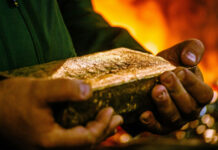[miningmx.com] — “THE group incurred a net loss for the six months ended 30 June 2005 of R213,9m (June 2003: R139,3m) and as of that date its total liabilities exceed its total assets by R29,1m.
“Lonmin has provided refinancing of the debt facilities to repay existing facilities and all overdue creditors. Accordingly, the financial statements are prepared on the basis of accounting policies applicable to a going concern.’
That remarkable extract from Messina’s latest interim results probably makes many an investment purist wonder why the JSE still allows the listing of this insolvent company. Still worse: why investors are still prepared to buy Messina at R35/share and put a total value of R662m on the mine. The loss is nearly twice that of a year ago, yet the share price doubled.
The answer is simple. Messina is a mine and apparently has reserves of no less than 20 million oz of 5PGE+AU (platinum group elements, plus gold) reserves – all at a depth of less than 1,000m and fairly easily mined.
That means the group has a great deal of platinum reserves. At the current price of almost $1,000 for the basket of platinum group metal (PGM) shares and an exchange rate of $1/R6,55 the reserves are worth considerably more than R100bn.
That explains why a mining company’s shares are still popular, even though it records one loss after the other. Investors simply accept that the reserves will be profitably exploited one day and that will result in so large a cash flow that they’ll be compensated for all their years of patience.
The same promise of future profit from huge reserves also accounts for the healthy share prices of gold mines such as Harmony, Western Areas and (even until recently) that of JCI. Though all three have huge reserves, they’re currently chalking up large losses. Something remarkable will have to happen with their operating costs, or the price of their product, or with the US dollar/rand exchange rate – or even all of them together – for these mines to return to a profit-earning status.
However, that doesn’t put off investors, who prefer to keep their focus on the reserves.
After the delisting of diamond producer De Beers about three years ago, Messina – which has been listed on the JSE since 1908 – is, as far as we can determine, the oldest listed company. This former copper producer right on the northern border of South Africa was established on reserves that were probably mined by the original inhabitants of the Zimbabwe Ruins (not to be confused with the current Zimbabwe ruins under Robert Mugabe).
As the copper reserves became exhausted and the price bogged down, Messina had to seek other opportunities; at one stage it was even the owner of Nissan SA.
The mine’s big breakthrough came about 10 years ago, when the platinum price began getting far ahead of the gold price and the metal became South Africa’s biggest earner of forex.
Messina always had large, though low-grade, platinum reserves. But those only recently became possibly profitable. Of course, that did wonders for the mine’s share price. From stagnation at 200c until as recently as 1998, it rocketed to just under R100/share in 2002, even outperforming all the IT miracles of the time as the best share.
Then Messina made a serious mistake by violating one of the basic rules of learned from South African gold mining in the old days of the 1890s. “Never spoil a good mine by sinking a shaft’ was one of the golden rules of those days. Many Canadian mines still believe in it today.
Nothing much came of Messina’s efforts to mine part of the platinum discovered by its neighbour, Hans Merensky, shortly after the 1933 Depression.
By the first quarter of 2005, the mine was financially on the floor after recording a R196m loss for the year to December 2004. By that time the Canadian company Southern Platinum, which had a 91,5% interest in Messina, was desperately seeking new funding. The price fell to R16/share.
Rand Merchant Bank, which stood at the head of a consortium to try to refinance the mine, was reasonably apathetic. By June 2005, after the share had recovered well, the widely expected announcement followed that Lonmin, formerly known as Lonrho and one of the most experienced mining houses ever to do business in Africa, had taken over Southern Platinum entirely.
Now the massive Lonmin is the owner of 91,5% of Messina – and that’s why it really makes no difference if the old copper mine’s liabilities are far higher than its assets.
If Lonmin undertakes to support you financially and to help you with mining, there may indeed be a chance of your huge platinum reserves being exploited one day.
That’s good news for South Africa – but not necessarily for the small group of minority shareholders in Messina. Lonmin doesn’t really have a good record of being interested in enriching minority shareholders. And that probably won’t happen at Messina either.
But watch this space: the JSE’s oldest listed company may well disappear soon and, like De Beers, re-emerge elsewhere in a slightly different guise. However, nobody can exploit Hans Merensky’s platinum reserves without South Africa as a whole benefiting.











